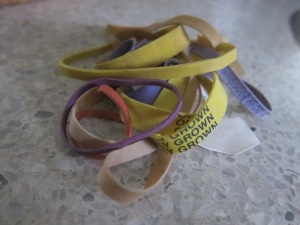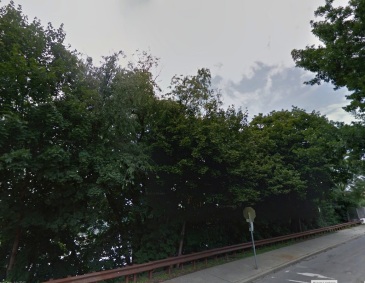 Suddenly I find myself in a sea of rubber bands. Squirmy mounds of bands of varying thickness and lengths sit in a bowl like clusters of rainbow-colored seaweed. They are everywhere. Wasn’t there a time when they nearly disappeared? I am remembering a while ago, maybe the later half of the 20th century, when they weren’t being used as much in offices, schools and homes as they once were.
Suddenly I find myself in a sea of rubber bands. Squirmy mounds of bands of varying thickness and lengths sit in a bowl like clusters of rainbow-colored seaweed. They are everywhere. Wasn’t there a time when they nearly disappeared? I am remembering a while ago, maybe the later half of the 20th century, when they weren’t being used as much in offices, schools and homes as they once were.
My fascination with rubber bands started early. I always liked the friendly nature of their form and substance. First, they are round in a predominately square world. But they are shape-shifters, too. Their diameters vary, as do their widths and thicknesses and colors; I have seen some as tiny as a half-inch in total or nearly as long as my forearm. They seem to be one of the longer-lasting, unsung, amazing albeit small, ubiquitous products of the 20th century, after having been patented in the 19th. But the patent is a johnny-come-lately; as states a Wikipedia entry, “Mesoamerican peoples had already produced vulcanized rubber items, including rubber bands, by 1600 BCE.” They did, after all, have the rubber trees within reach.
Lately, I find them everywhere. Our mailman uses them (the large industrial tan or natural-color ones) to bind together individual households’ mail. As he makes his deliveries, he drops the rubber bands on the ground. Not environmentally sound thinking, but you could probably follow his trail of rubber bands to learn his mail route.
I also have noticed that much of the produce I buy is bunched in rubber bands: wide purple or yellow ones, thinner blue ones wrapped multiple times. Some leafy greens still employ large-scale twist-ties – like regular ties on steroids – but many more bunches of vegetable matter, whether shipped in or locally grown, are sporting festive rubber bands. I have such a large collection of them now, I feel that someone ought to figure out another purpose for them. I do reuse some and I have learned a few things indirectly about their properties and uses, slingshots aside.
1. They don’t freeze well. In a freezer, the rubber fails, dries out, becomes inelastic.
2. They can be cheap, attractive bracelets but they should be loose on your arm.
3. Things that aren’t too thick and you can roll up, like blueprints and maps, are perfectly suited to rubber bands to hold them steady. Eventually, they will dry out and loosen.
4. If you are a jerk and want to annoy someone, you can shoot rubber bands in his/her direction – but avoid the eyes.
5. They are a good way to hold wound-up electrical cords together, when a twist-tie just won’t handle it (unless you happen to have saved one of the huge ones from produce).
6. They are not good to pick up in a vacuum cleaner, and happily, it is difficult to do so. Somehow, their lack of substance and friction-y surface help to discourage that.
7. They are miracle healers. If they break – unlike so many other binding technologies – all you have to do is tie the ends together and there you go again … a little smaller, perhaps, and a tad more fragile, but usable. A second life.
8. There are so many ways to store rubber bands: in a box or envelope or any containing vessel, in baskets (as we do), on long rods either sticking up from a desk or out from vertical surface. One can even keep rubber bands rolled up in a ball. Indeed, there are those for whom this is not just a practical thing but a hobby or work of art.

9. In an irony not lost on the consortium of rubber-band producers (there must be some such organization somewhere), rubber bands have supplanted the fuzzy, slightly elastic, so-called “stocking tops” as the binder of choice for home-delivered newspapers … just as newspapers are taking a nosedive into oblivion. Millions of such band/paper pairings occur, still, to this day, every year..
10. A rubber band can be a terrifically annoying, almost non-musical musical instrument. Stretch, pluck – twang/plunk. Over and over.
11. Without a rubber band, there would be no paddle-ball. From one’s personal perspective, this is either a benefit or an indictment.
12. Unlike paper clips, staples, paper clasps and other such metallic binding products, a box of rubber bands if accidentally dumped on the floor will not make a sound that will draw the attention of the person whose desk you have raided to “borrow” such items. Rubber bands are willfully complicit in all crimes.
13. They may be soft, bendable, twistable, squeezable, roll-up-able – and, yet, they can really sting when you’ve had one snap against your skin. And as easily breakable as they are, put them in the array of braces on your teeth, and they not only have the strength to reduce an overbite but can also cause a great amount of soreness and pain and headache, not to mention embarrassment. All from those tiniest of rubbery squiggles.
14. Keep them away from animals; they have appeal to all creatures and you don’t want any to end up in a digestive tract.
Rubber bands are, at this point, part of our genetic make-up. They are without affect or personality but there is a placeness to their presence in our everyday world, and by their very nature, functionally, they create placeness by limiting and encircling and defining, determinedly and yet forgivingly. If they were not around, it would be a harsh and rigid place with only paper clips, staples, clasps and the unyielding like.









































